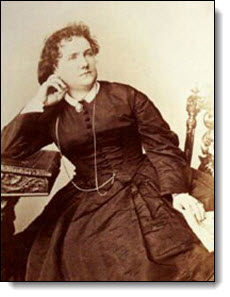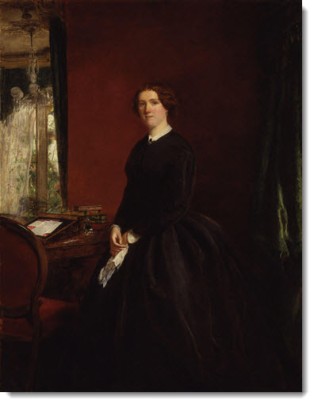 Mary Elizabeth Braddon, born 4 October 1835, would lie to many of her peers in later years about her age (telling some she had been born later, in 1837), but the unavoidable truth is that the Queen of Sensation Fiction turned 40 in 1875, a time in which she was both subjected to and released from scandal, where she waved goodbye to editorial pressures, and continued a prolific production of novels, though not to everyone’s taste.
Mary Elizabeth Braddon, born 4 October 1835, would lie to many of her peers in later years about her age (telling some she had been born later, in 1837), but the unavoidable truth is that the Queen of Sensation Fiction turned 40 in 1875, a time in which she was both subjected to and released from scandal, where she waved goodbye to editorial pressures, and continued a prolific production of novels, though not to everyone’s taste.
Braddon’s life is riddled with scandal and claims of impropriety, some of it unfair (Shock! Horror! She was an actress before she became an author!), some of it…a little more fair – since 1861 she had been living with John Maxwell, publisher, editor and (gasp!) married man. With Maxwell’s wife living with her family, Braddon and Maxwell had a happy relationship despite Victorian values and together they had six children, with Maxwell staving off critics by claiming that he and Braddon were in fact married. This ruse became somewhat complicated on 5 September 1874 when Maxwell’s wife died, and he battled in vain to keep the obituaries out of the press. News of his wife’s death led to a revival of criticism against he and Braddon for their ‘sinful’ relationship, the happy ending to this being that they were able at last to marry and legitimise their relationship on the 2 October 1874. The couple still had to move out of the area to avoid gossip and judgmental stares, but by the following year they returned to their home in Lichfield: the 40-year old Braddon was finally able to enjoy a little respectability.
 Professionally, her career was booming. Quite apart from her writing career (more on that anon), she had, since 1866 been editing Belgravia magazine, which enjoyed an overflow of submissions for Braddon to choose from and keep her busy – perhaps a little too busy, and in 1876 Braddon would actually resign from her editorial role, followed soon after by selling the magazine in 1878. This at least gave her time to focus more on her novels.
Professionally, her career was booming. Quite apart from her writing career (more on that anon), she had, since 1866 been editing Belgravia magazine, which enjoyed an overflow of submissions for Braddon to choose from and keep her busy – perhaps a little too busy, and in 1876 Braddon would actually resign from her editorial role, followed soon after by selling the magazine in 1878. This at least gave her time to focus more on her novels.
It has been said of Braddon that she was incredibly productive (indeed, for some people this was a reason not to study her, as her canon was seen as too large to meaningfully assess). Her two greatest hits were the sensation novels Lady Audley’s Secret (1862) and Aurora Floyd (1863), which both confirmed her fame and overshadowed the rest of her work, with her remembered today (see first paragraph) predominately, almost exclusively, for her sensation fiction. The work she produced when she was 40 included Strange World, Hostages to Fortune, Dead Men’s Shoes and John Haggard’s Daughter the latter two being commenced in 1875 and concluded the following year. An impressive output for an author, but not one that necessarily generate praise. A review in the Athenaeum of Dead Men’s Shoes complained that it was ‘one of the feeblest novels which Miss Braddon has ever written’. At its centre, as with her two most famous works, was a ‘heroine [who] is a disagreeable young woman’. Braddon’s productivity was held as a failing, her focus on creating many works being held as a cause for not creating more memorable ones. Today, Braddon studies is growing at an exponential rate, her popularity returning and her novels – all her novels – being seen as fit subject for academic study. In such a context, buoyed undoubtedly by the continued popularity of Lady Audley’s Secret and Aurora Floyd, her broader canon is beginning to receive kinder attention than previously, so that the Athenaeum’s complaints become ever more anachronistic.
Braddon at Buckingham: This article was written by Dr Pete Orford, who in his research on The Mystery of Edwin Drood by Charles Dickens is currently comparing the structure and tone of that novel with Braddon’s sensation work as a fairer model of comparison than Wilkie Collins. Lady Audley’s Secret is due to become a set text on Buckingham’s new module ‘Gothic, Sensation and Science Fiction’ which premieres later this year.
In the family (I am her great great granddaughter) we were told John Maxwells first wife was in an asylum and this was the reason he could not divorce her as it was law then. I believe her son WB Maxwell campaigned to change the law. Is this not true? If she lived in a menage a trois good on her. I am not a judgmental Victorian! Its in my blood to defy convention – thanks to M. E.. A remarkable woman.
LikeLike
Thank you for your comment Sally. While there was talk of an asylum, current academic consensus is that John’s first wife (also called Mary) was actually living with her family – I confess I’m not sure whether this was an alternative method of care to an asylum, or whether the whole asylum story was just a cover from John to provide respectability for his relationship with Braddon. Either way, to my knowledge, no-one has suggested she was living with John and Mary, so alas no menage a trois there!
LikeLike
Thanks for the reply. It was the wording as I understood ‘her family’ to be M.E.’s family. Wow that would have added an extra dimension! I know M.E. Brought up Johns kids from his first marriage pretty much. Another 5 or 6 on top of her’s. M.E. Plotted the elopement of her son Edward,my great grandfather with Maude Hudson who was from Worcestershire. M.E arranged for the bans to be read at a small church in London. By some fluke a couple from Worcestershire who knew Maudes family were at church. They heard the bans, thought it was very strange but luckily for me decided to keep quiet about it.
Excellent article by the way. Sally
LikeLike
Thank you – I’m glad you liked the article, and am pleased to see the Braddon flair for scandal living on in her children!
LikeLike
Forgot to say I think John Marchmont’s Legacy is a brilliant and accomplished novel. This is the best novel of hers I’ve read. Am also a fan of Vixen. Hope students study some of her later novels.
LikeLike